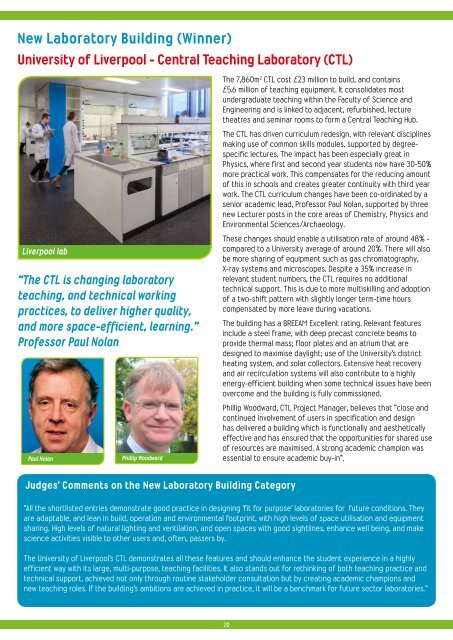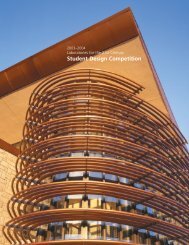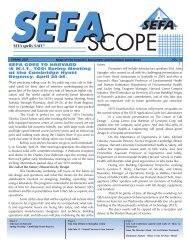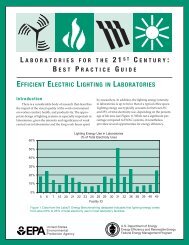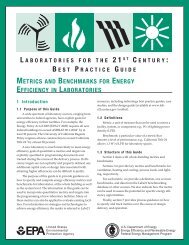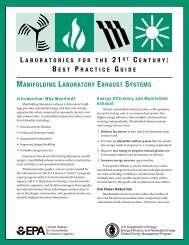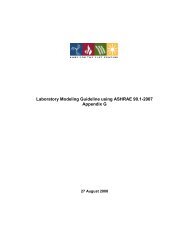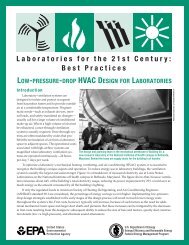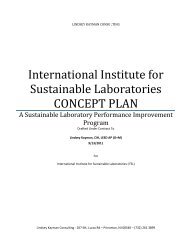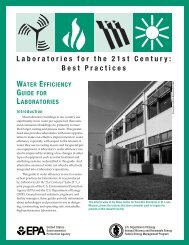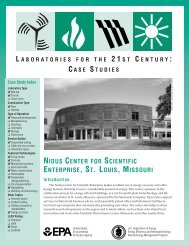Results of the 2012 S-Lab Awards and Conference The Effective ...
Results of the 2012 S-Lab Awards and Conference The Effective ...
Results of the 2012 S-Lab Awards and Conference The Effective ...
Create successful ePaper yourself
Turn your PDF publications into a flip-book with our unique Google optimized e-Paper software.
New <strong>Lab</strong>oratory Building (Winner)<br />
University <strong>of</strong> Liverpool - Central Teaching <strong>Lab</strong>oratory (CTL)<br />
<strong>The</strong> 7,860m 2 CTL cost £23 million to build, <strong>and</strong> contains<br />
£5.6 million <strong>of</strong> teaching equipment. It consolidates most<br />
undergraduate teaching within <strong>the</strong> Faculty <strong>of</strong> Science <strong>and</strong><br />
Engineering <strong>and</strong> is linked to adjacent, refurbished, lecture<br />
<strong>the</strong>atres <strong>and</strong> seminar rooms to form a Central Teaching Hub.<br />
<strong>The</strong> CTL has driven curriculum redesign, with relevant disciplines<br />
making use <strong>of</strong> common skills modules, supported by degreespecific<br />
lectures. <strong>The</strong> impact has been especially great in<br />
Physics, where first <strong>and</strong> second year students now have 30-50%<br />
more practical work. This compensates for <strong>the</strong> reducing amount<br />
<strong>of</strong> this in schools <strong>and</strong> creates greater continuity with third year<br />
work. <strong>The</strong> CTL curriculum changes have been co-ordinated by a<br />
senior academic lead, Pr<strong>of</strong>essor Paul Nolan, supported by three<br />
new Lecturer posts in <strong>the</strong> core areas <strong>of</strong> Chemistry, Physics <strong>and</strong><br />
Environmental Sciences/Archaeology.<br />
Liverpool lab<br />
“<strong>The</strong> CTL is changing laboratory<br />
teaching, <strong>and</strong> technical working<br />
practices, to deliver higher quality,<br />
<strong>and</strong> more space-efficient, learning.”<br />
Pr<strong>of</strong>essor Paul Nolan<br />
Paul Nolan<br />
Phillip Woodward<br />
<strong>The</strong>se changes should enable a utilisation rate <strong>of</strong> around 48% -<br />
compared to a University average <strong>of</strong> around 20%. <strong>The</strong>re will also<br />
be more sharing <strong>of</strong> equipment such as gas chromatography,<br />
X-ray systems <strong>and</strong> microscopes. Despite a 35% increase in<br />
relevant student numbers, <strong>the</strong> CTL requires no additional<br />
technical support. This is due to more multiskilling <strong>and</strong> adoption<br />
<strong>of</strong> a two-shift pattern with slightly longer term-time hours<br />
compensated by more leave during vacations.<br />
<strong>The</strong> building has a BREEAM Excellent rating. Relevant features<br />
include a steel frame, with deep precast concrete beams to<br />
provide <strong>the</strong>rmal mass; floor plates <strong>and</strong> an atrium that are<br />
designed to maximise daylight; use <strong>of</strong> <strong>the</strong> University’s district<br />
heating system, <strong>and</strong> solar collectors. Extensive heat recovery<br />
<strong>and</strong> air recirculation systems will also contribute to a highly<br />
energy-efficient building when some technical issues have been<br />
overcome <strong>and</strong> <strong>the</strong> building is fully commissioned.<br />
Phillip Woodward, CTL Project Manager, believes that “close <strong>and</strong><br />
continued involvement <strong>of</strong> users in specification <strong>and</strong> design<br />
has delivered a building which is functionally <strong>and</strong> aes<strong>the</strong>tically<br />
effective <strong>and</strong> has ensured that <strong>the</strong> opportunities for shared use<br />
<strong>of</strong> resources are maximised. A strong academic champion was<br />
essential to ensure academic buy-in”.<br />
Judges’ Comments on <strong>the</strong> New <strong>Lab</strong>oratory Building Category<br />
“All <strong>the</strong> shortlisted entries demonstrate good practice in designing ‘fit for purpose’ laboratories for future conditions. <strong>The</strong>y<br />
are adaptable, <strong>and</strong> lean in build, operation <strong>and</strong> environmental footprint, with high levels <strong>of</strong> space utilisation <strong>and</strong> equipment<br />
sharing. High levels <strong>of</strong> natural lighting <strong>and</strong> ventilation, <strong>and</strong> open spaces with good sightlines, enhance well being, <strong>and</strong> make<br />
science activities visible to o<strong>the</strong>r users <strong>and</strong>, <strong>of</strong>ten, passers by.<br />
<strong>The</strong> University <strong>of</strong> Liverpool’s CTL demonstrates all <strong>the</strong>se features <strong>and</strong> should enhance <strong>the</strong> student experience in a highly<br />
efficient way with its large, multi-purpose, teaching facilities. It also st<strong>and</strong>s out for rethinking <strong>of</strong> both teaching practice <strong>and</strong><br />
technical support, achieved not only through routine stakeholder consultation but by creating academic champions <strong>and</strong><br />
new teaching roles. If <strong>the</strong> building’s ambitions are achieved in practice, it will be a benchmark for future sector laboratories.”<br />
20


